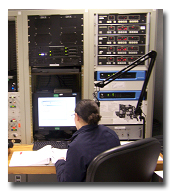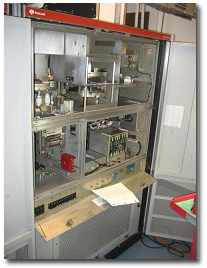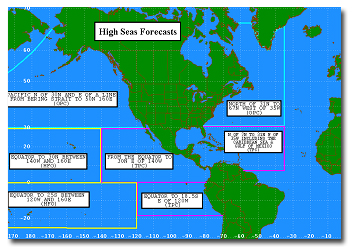Decision made to continue providing high frequency (HF) radio broadcasts of weather forcasts and warnings.
In April 2007 the Coast Guard issued a Notice requesting public comments on the need to continue HF radio broadcasts of weather forecasts. Comments closed on August 24, 2007.
A business case analysis report was prepared based upon the responses. The report concluded that:
"The responding public collectively perceives that the USCG HF broadcasts are essential to their safety. There is no viable alternative to the USCG HF broadcasts because present alternatives are perceived by the public to be out of financial reach. Also, marine weather forecasts available through these alternative sources may not guarantee the same level of accuracy, timeliness, and/or sufficiency as provided by the USCG HF broadcasts."

Above: Broadcast position at COMMCOM, Chesapeake VA
The Coast Guard's HF infrastructure.
The Coast Guard’s HF infrastructure consisting of 123 10KW transmitters are no longer supportable. Repair parts are increasingly difficult to find, more expensive, and can take months to obtain. Funds should be available to replace many, but not all of these transmitters. Consequently all but the most essential HF services are or will be terminated. However, due to responsive received from the public and the conclusions of the business case report, the Coast Guard has decided to continue HF broadcasts of high seas weather forecasts and warnings without interruption. Transmitters used for this purpose will be included among those recapitalized.

Above: Rockwell Collins 10KW HF80 (and Harris RF-755) transmitters at end of useful life
The Coast Guard uses 20 high power transmitters to broadcast HF weather facsimile, voice and text (SITOR) high seas weather forecasts to mariners. Three additional Navy transmitters are used to broadcast weather information from Guam. The cost to replace one of these transmitters is ~$200K with installation ($4M total for those used for weather broadcasts).
Reliable, high power transmitters are needed to ensure mariners can reliably receive weather information anywhere within the National Weather Service’s area of responsibility.
Click here to view a larger and much more clear version of the image below (doing so will open a new browser window). If you are using Internet Explorer, you may have to click on the image yet again in the new browser window to view it at its full size.

Note: VHF (Channel 22A) broadcasts are not in any way affected by this notice, nor are Coast Guard voice broadcasts on 2670 kHz single sideband..
For More Information:
U.S. Coast Guard brief given to the radio technical Commission for Maritime Services (RTCM) Assembly May 2007
U.S. Coast Guard Maritime Safety Information broadcasts
Final Report - United States Coast Guard High-frequency Broadcasts of National Weather Service Marine Weather Forecasts.

